Leadership and Management: Managing Key Stakeholders & Stakeholders Relationship Management
VerifiedAdded on 2023/04/24
|13
|2575
|209
AI Summary
This document discusses managing key stakeholders and stakeholders relationship management in Leadership and Management. It covers internal and external stakeholders, stakeholders engagement, engagement methods, reasons for stakeholder relationship management, effectiveness of the stakeholders’ relationship management system, and three ways to maintain sustainable stakeholders’ relationship management system. The stakeholders’ circle methodology is also explained. The document is suitable for students studying Leadership and Management.
Contribute Materials
Your contribution can guide someone’s learning journey. Share your
documents today.
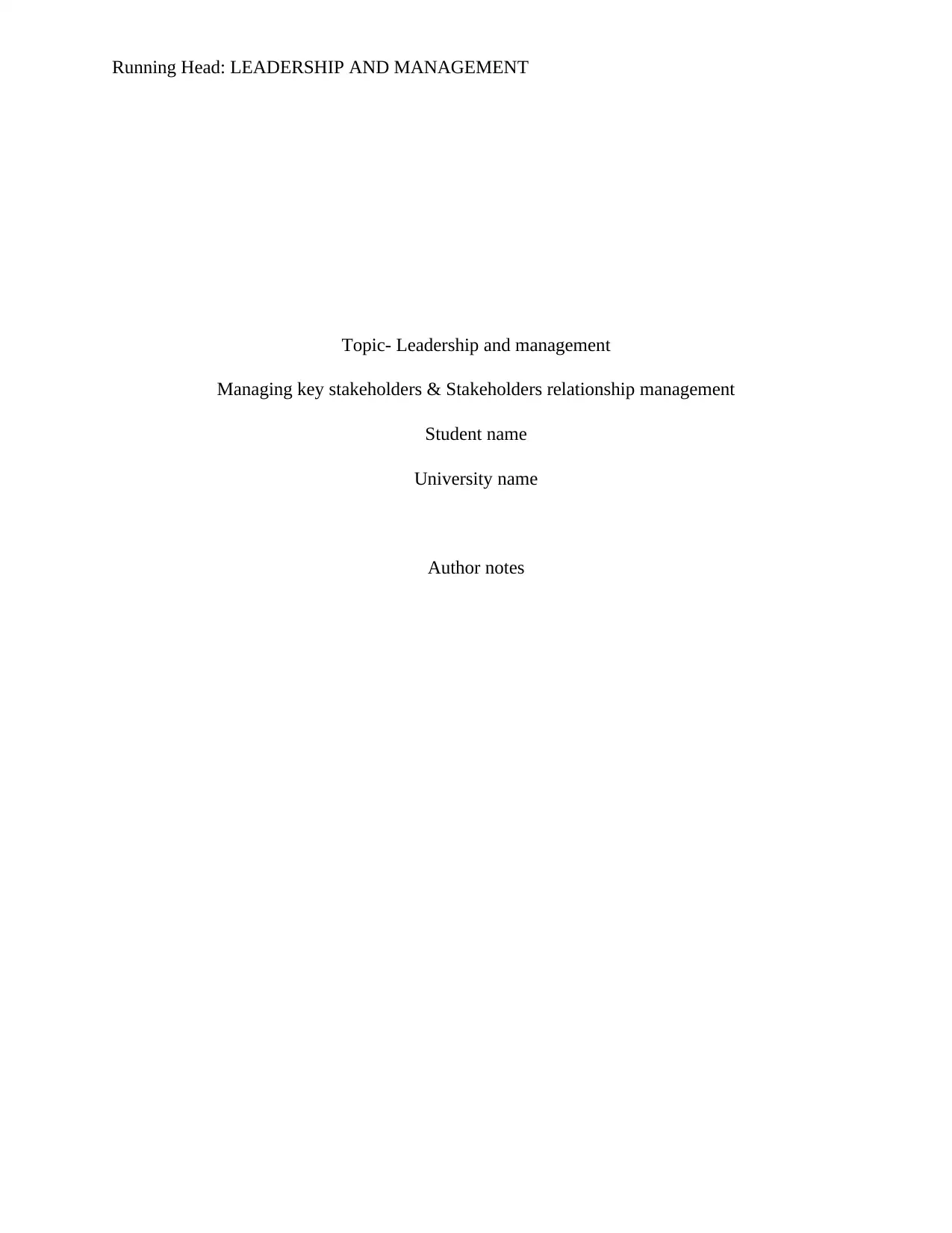
Running Head: LEADERSHIP AND MANAGEMENT
Topic- Leadership and management
Managing key stakeholders & Stakeholders relationship management
Student name
University name
Author notes
Topic- Leadership and management
Managing key stakeholders & Stakeholders relationship management
Student name
University name
Author notes
Secure Best Marks with AI Grader
Need help grading? Try our AI Grader for instant feedback on your assignments.
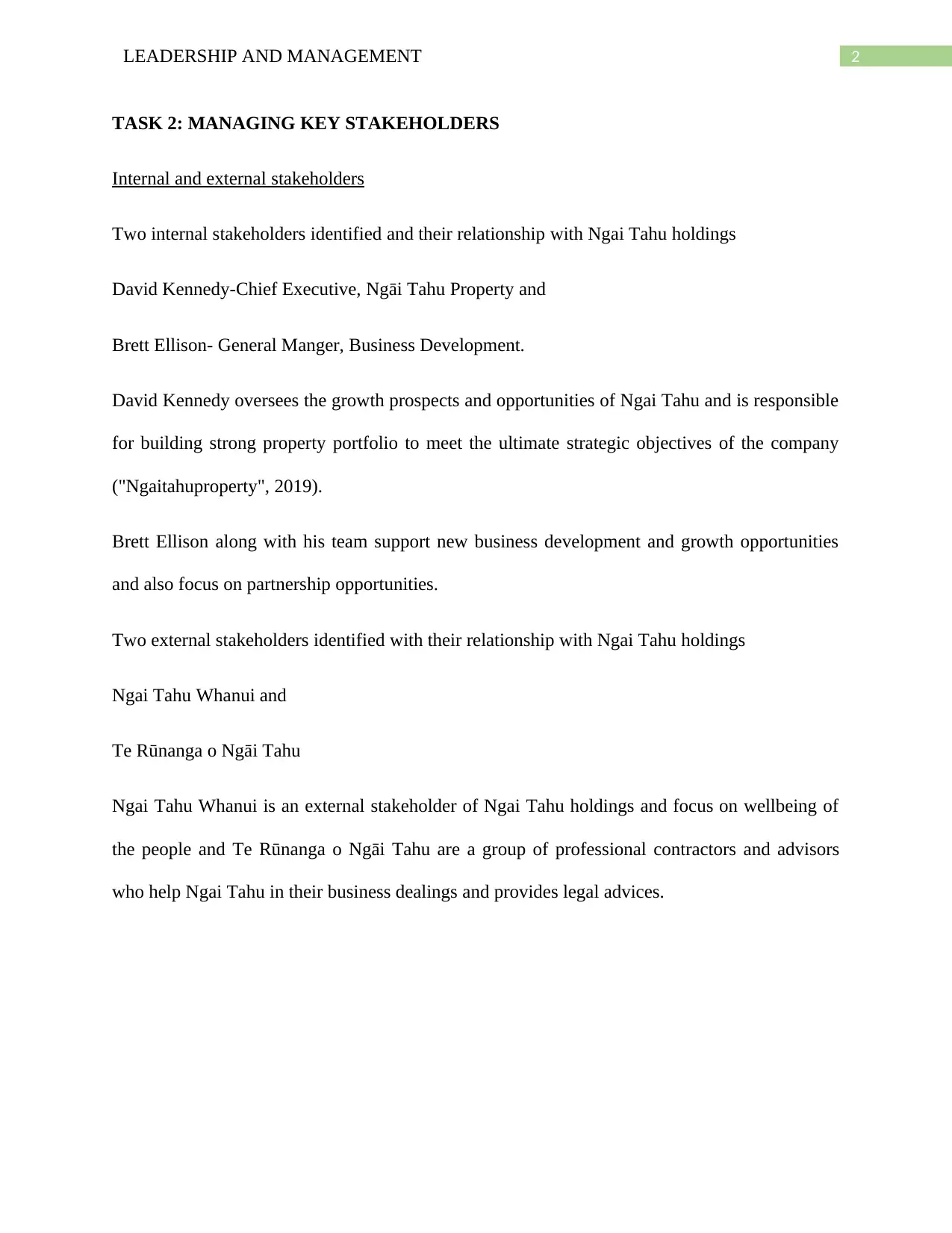
2LEADERSHIP AND MANAGEMENT
TASK 2: MANAGING KEY STAKEHOLDERS
Internal and external stakeholders
Two internal stakeholders identified and their relationship with Ngai Tahu holdings
David Kennedy-Chief Executive, Ngāi Tahu Property and
Brett Ellison- General Manger, Business Development.
David Kennedy oversees the growth prospects and opportunities of Ngai Tahu and is responsible
for building strong property portfolio to meet the ultimate strategic objectives of the company
("Ngaitahuproperty", 2019).
Brett Ellison along with his team support new business development and growth opportunities
and also focus on partnership opportunities.
Two external stakeholders identified with their relationship with Ngai Tahu holdings
Ngai Tahu Whanui and
Te Rūnanga o Ngāi Tahu
Ngai Tahu Whanui is an external stakeholder of Ngai Tahu holdings and focus on wellbeing of
the people and Te Rūnanga o Ngāi Tahu are a group of professional contractors and advisors
who help Ngai Tahu in their business dealings and provides legal advices.
TASK 2: MANAGING KEY STAKEHOLDERS
Internal and external stakeholders
Two internal stakeholders identified and their relationship with Ngai Tahu holdings
David Kennedy-Chief Executive, Ngāi Tahu Property and
Brett Ellison- General Manger, Business Development.
David Kennedy oversees the growth prospects and opportunities of Ngai Tahu and is responsible
for building strong property portfolio to meet the ultimate strategic objectives of the company
("Ngaitahuproperty", 2019).
Brett Ellison along with his team support new business development and growth opportunities
and also focus on partnership opportunities.
Two external stakeholders identified with their relationship with Ngai Tahu holdings
Ngai Tahu Whanui and
Te Rūnanga o Ngāi Tahu
Ngai Tahu Whanui is an external stakeholder of Ngai Tahu holdings and focus on wellbeing of
the people and Te Rūnanga o Ngāi Tahu are a group of professional contractors and advisors
who help Ngai Tahu in their business dealings and provides legal advices.
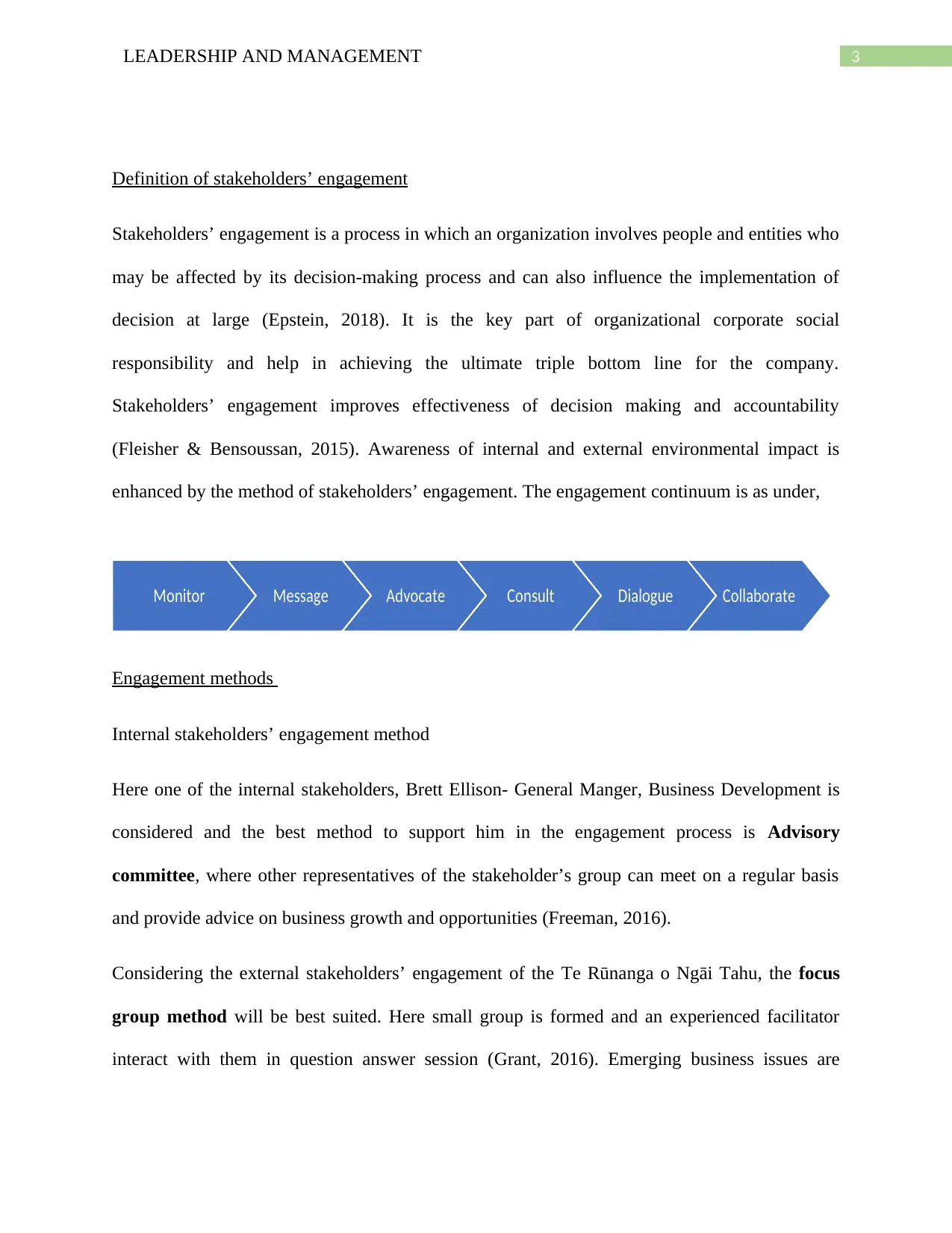
3LEADERSHIP AND MANAGEMENT
Definition of stakeholders’ engagement
Stakeholders’ engagement is a process in which an organization involves people and entities who
may be affected by its decision-making process and can also influence the implementation of
decision at large (Epstein, 2018). It is the key part of organizational corporate social
responsibility and help in achieving the ultimate triple bottom line for the company.
Stakeholders’ engagement improves effectiveness of decision making and accountability
(Fleisher & Bensoussan, 2015). Awareness of internal and external environmental impact is
enhanced by the method of stakeholders’ engagement. The engagement continuum is as under,
Engagement methods
Internal stakeholders’ engagement method
Here one of the internal stakeholders, Brett Ellison- General Manger, Business Development is
considered and the best method to support him in the engagement process is Advisory
committee, where other representatives of the stakeholder’s group can meet on a regular basis
and provide advice on business growth and opportunities (Freeman, 2016).
Considering the external stakeholders’ engagement of the Te Rūnanga o Ngāi Tahu, the focus
group method will be best suited. Here small group is formed and an experienced facilitator
interact with them in question answer session (Grant, 2016). Emerging business issues are
Monitor Message Advocate Consult Dialogue Collaborate
Definition of stakeholders’ engagement
Stakeholders’ engagement is a process in which an organization involves people and entities who
may be affected by its decision-making process and can also influence the implementation of
decision at large (Epstein, 2018). It is the key part of organizational corporate social
responsibility and help in achieving the ultimate triple bottom line for the company.
Stakeholders’ engagement improves effectiveness of decision making and accountability
(Fleisher & Bensoussan, 2015). Awareness of internal and external environmental impact is
enhanced by the method of stakeholders’ engagement. The engagement continuum is as under,
Engagement methods
Internal stakeholders’ engagement method
Here one of the internal stakeholders, Brett Ellison- General Manger, Business Development is
considered and the best method to support him in the engagement process is Advisory
committee, where other representatives of the stakeholder’s group can meet on a regular basis
and provide advice on business growth and opportunities (Freeman, 2016).
Considering the external stakeholders’ engagement of the Te Rūnanga o Ngāi Tahu, the focus
group method will be best suited. Here small group is formed and an experienced facilitator
interact with them in question answer session (Grant, 2016). Emerging business issues are
Monitor Message Advocate Consult Dialogue Collaborate
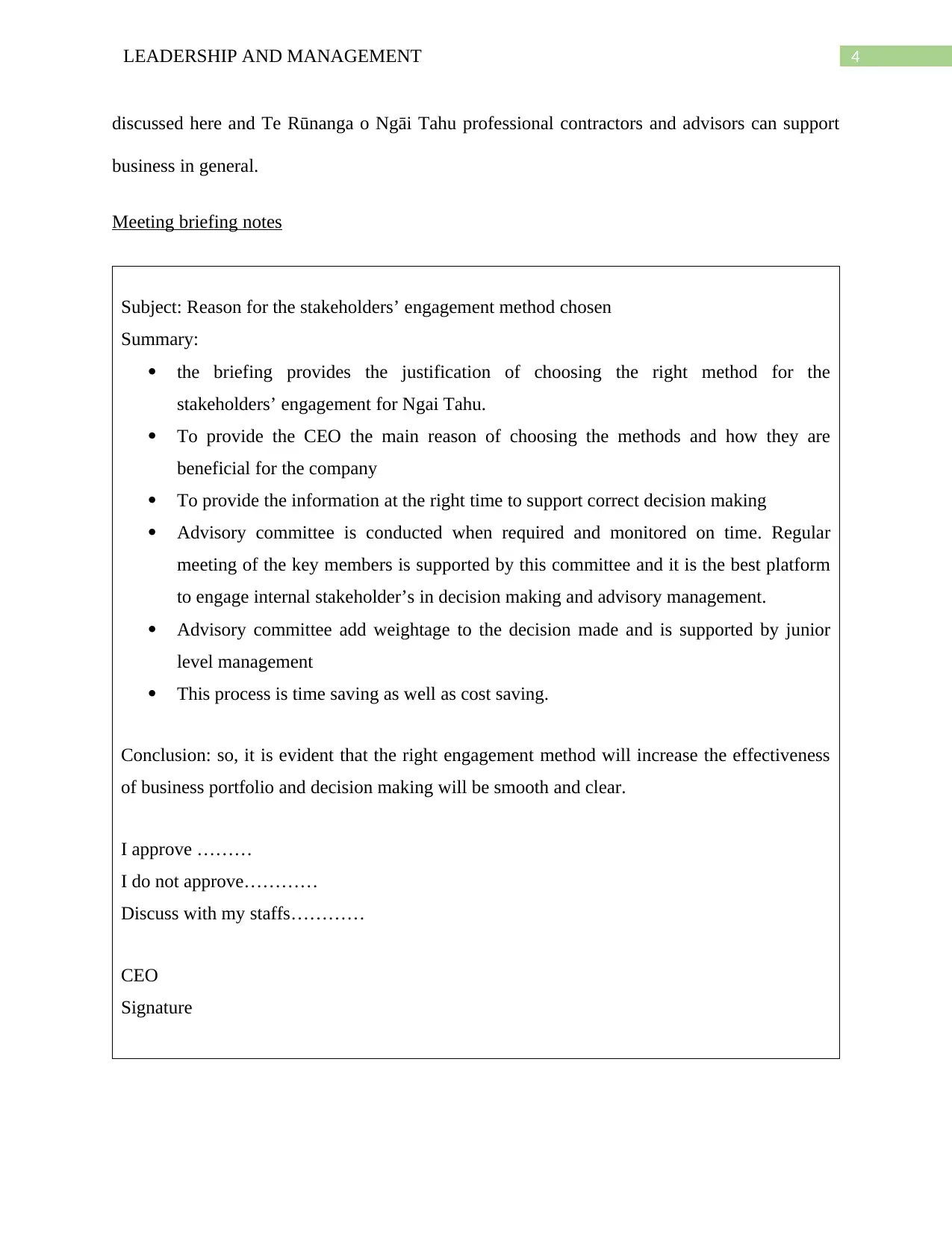
4LEADERSHIP AND MANAGEMENT
discussed here and Te Rūnanga o Ngāi Tahu professional contractors and advisors can support
business in general.
Meeting briefing notes
Subject: Reason for the stakeholders’ engagement method chosen
Summary:
the briefing provides the justification of choosing the right method for the
stakeholders’ engagement for Ngai Tahu.
To provide the CEO the main reason of choosing the methods and how they are
beneficial for the company
To provide the information at the right time to support correct decision making
Advisory committee is conducted when required and monitored on time. Regular
meeting of the key members is supported by this committee and it is the best platform
to engage internal stakeholder’s in decision making and advisory management.
Advisory committee add weightage to the decision made and is supported by junior
level management
This process is time saving as well as cost saving.
Conclusion: so, it is evident that the right engagement method will increase the effectiveness
of business portfolio and decision making will be smooth and clear.
I approve ………
I do not approve…………
Discuss with my staffs…………
CEO
Signature
discussed here and Te Rūnanga o Ngāi Tahu professional contractors and advisors can support
business in general.
Meeting briefing notes
Subject: Reason for the stakeholders’ engagement method chosen
Summary:
the briefing provides the justification of choosing the right method for the
stakeholders’ engagement for Ngai Tahu.
To provide the CEO the main reason of choosing the methods and how they are
beneficial for the company
To provide the information at the right time to support correct decision making
Advisory committee is conducted when required and monitored on time. Regular
meeting of the key members is supported by this committee and it is the best platform
to engage internal stakeholder’s in decision making and advisory management.
Advisory committee add weightage to the decision made and is supported by junior
level management
This process is time saving as well as cost saving.
Conclusion: so, it is evident that the right engagement method will increase the effectiveness
of business portfolio and decision making will be smooth and clear.
I approve ………
I do not approve…………
Discuss with my staffs…………
CEO
Signature
Secure Best Marks with AI Grader
Need help grading? Try our AI Grader for instant feedback on your assignments.
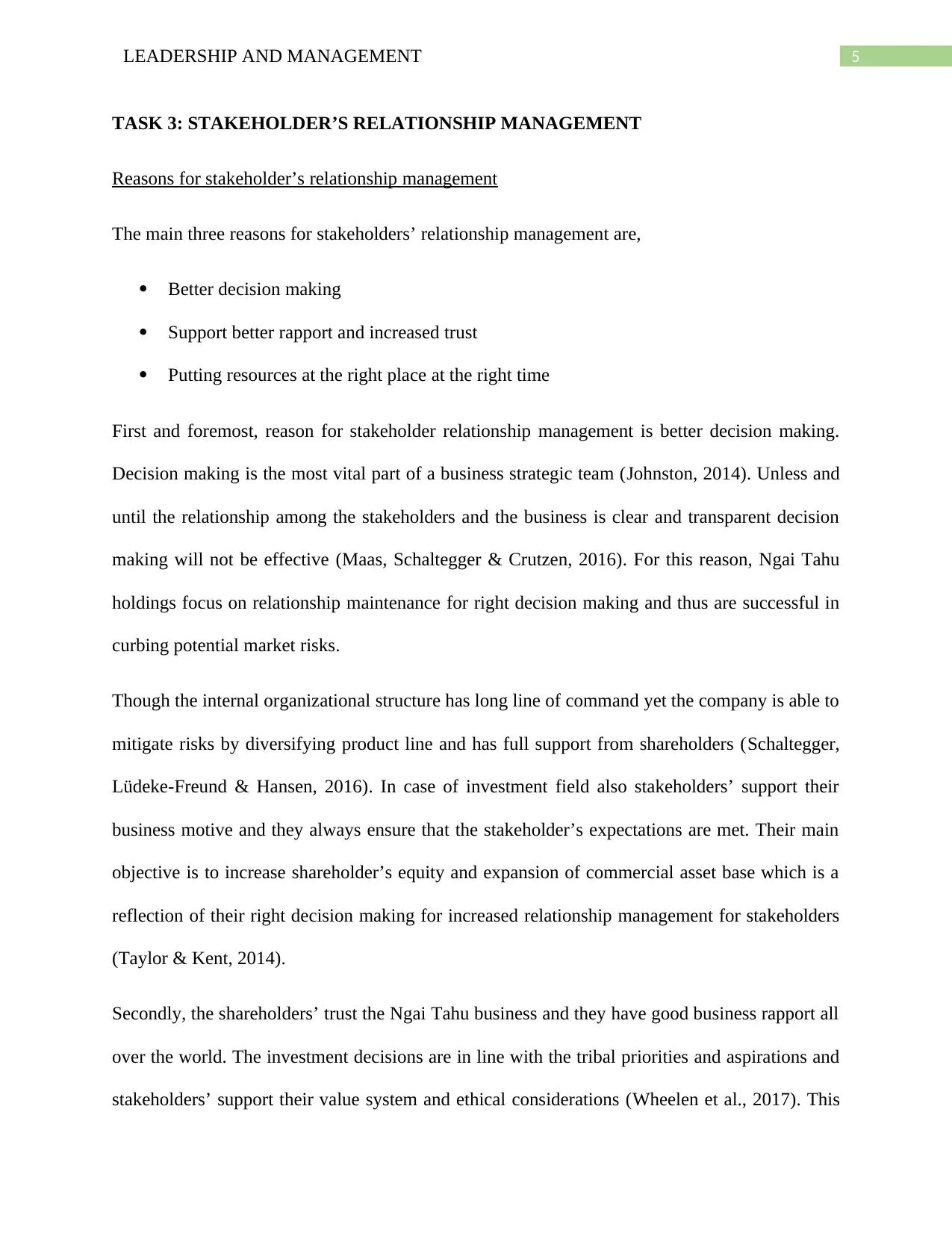
5LEADERSHIP AND MANAGEMENT
TASK 3: STAKEHOLDER’S RELATIONSHIP MANAGEMENT
Reasons for stakeholder’s relationship management
The main three reasons for stakeholders’ relationship management are,
Better decision making
Support better rapport and increased trust
Putting resources at the right place at the right time
First and foremost, reason for stakeholder relationship management is better decision making.
Decision making is the most vital part of a business strategic team (Johnston, 2014). Unless and
until the relationship among the stakeholders and the business is clear and transparent decision
making will not be effective (Maas, Schaltegger & Crutzen, 2016). For this reason, Ngai Tahu
holdings focus on relationship maintenance for right decision making and thus are successful in
curbing potential market risks.
Though the internal organizational structure has long line of command yet the company is able to
mitigate risks by diversifying product line and has full support from shareholders (Schaltegger,
Lüdeke-Freund & Hansen, 2016). In case of investment field also stakeholders’ support their
business motive and they always ensure that the stakeholder’s expectations are met. Their main
objective is to increase shareholder’s equity and expansion of commercial asset base which is a
reflection of their right decision making for increased relationship management for stakeholders
(Taylor & Kent, 2014).
Secondly, the shareholders’ trust the Ngai Tahu business and they have good business rapport all
over the world. The investment decisions are in line with the tribal priorities and aspirations and
stakeholders’ support their value system and ethical considerations (Wheelen et al., 2017). This
TASK 3: STAKEHOLDER’S RELATIONSHIP MANAGEMENT
Reasons for stakeholder’s relationship management
The main three reasons for stakeholders’ relationship management are,
Better decision making
Support better rapport and increased trust
Putting resources at the right place at the right time
First and foremost, reason for stakeholder relationship management is better decision making.
Decision making is the most vital part of a business strategic team (Johnston, 2014). Unless and
until the relationship among the stakeholders and the business is clear and transparent decision
making will not be effective (Maas, Schaltegger & Crutzen, 2016). For this reason, Ngai Tahu
holdings focus on relationship maintenance for right decision making and thus are successful in
curbing potential market risks.
Though the internal organizational structure has long line of command yet the company is able to
mitigate risks by diversifying product line and has full support from shareholders (Schaltegger,
Lüdeke-Freund & Hansen, 2016). In case of investment field also stakeholders’ support their
business motive and they always ensure that the stakeholder’s expectations are met. Their main
objective is to increase shareholder’s equity and expansion of commercial asset base which is a
reflection of their right decision making for increased relationship management for stakeholders
(Taylor & Kent, 2014).
Secondly, the shareholders’ trust the Ngai Tahu business and they have good business rapport all
over the world. The investment decisions are in line with the tribal priorities and aspirations and
stakeholders’ support their value system and ethical considerations (Wheelen et al., 2017). This
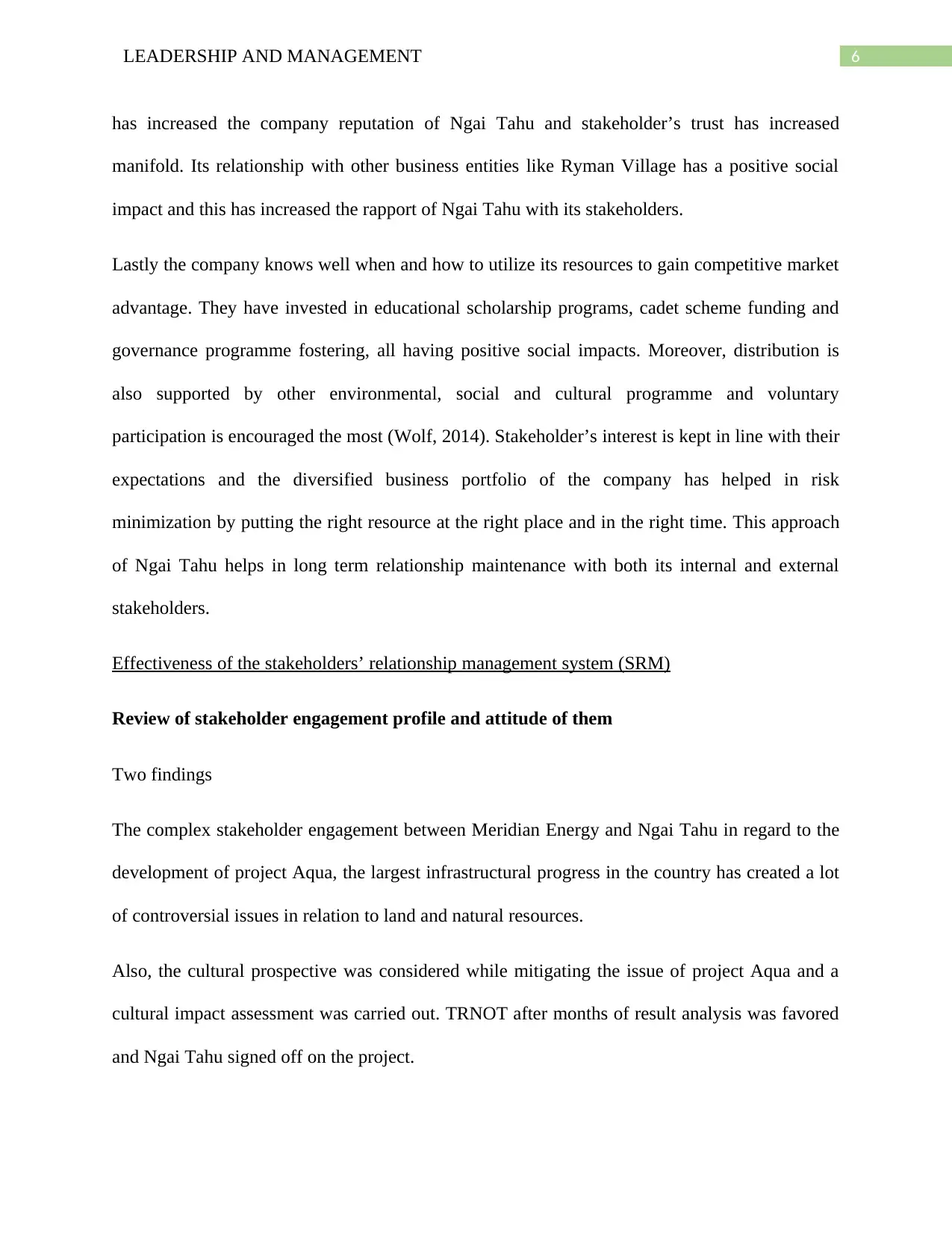
6LEADERSHIP AND MANAGEMENT
has increased the company reputation of Ngai Tahu and stakeholder’s trust has increased
manifold. Its relationship with other business entities like Ryman Village has a positive social
impact and this has increased the rapport of Ngai Tahu with its stakeholders.
Lastly the company knows well when and how to utilize its resources to gain competitive market
advantage. They have invested in educational scholarship programs, cadet scheme funding and
governance programme fostering, all having positive social impacts. Moreover, distribution is
also supported by other environmental, social and cultural programme and voluntary
participation is encouraged the most (Wolf, 2014). Stakeholder’s interest is kept in line with their
expectations and the diversified business portfolio of the company has helped in risk
minimization by putting the right resource at the right place and in the right time. This approach
of Ngai Tahu helps in long term relationship maintenance with both its internal and external
stakeholders.
Effectiveness of the stakeholders’ relationship management system (SRM)
Review of stakeholder engagement profile and attitude of them
Two findings
The complex stakeholder engagement between Meridian Energy and Ngai Tahu in regard to the
development of project Aqua, the largest infrastructural progress in the country has created a lot
of controversial issues in relation to land and natural resources.
Also, the cultural prospective was considered while mitigating the issue of project Aqua and a
cultural impact assessment was carried out. TRNOT after months of result analysis was favored
and Ngai Tahu signed off on the project.
has increased the company reputation of Ngai Tahu and stakeholder’s trust has increased
manifold. Its relationship with other business entities like Ryman Village has a positive social
impact and this has increased the rapport of Ngai Tahu with its stakeholders.
Lastly the company knows well when and how to utilize its resources to gain competitive market
advantage. They have invested in educational scholarship programs, cadet scheme funding and
governance programme fostering, all having positive social impacts. Moreover, distribution is
also supported by other environmental, social and cultural programme and voluntary
participation is encouraged the most (Wolf, 2014). Stakeholder’s interest is kept in line with their
expectations and the diversified business portfolio of the company has helped in risk
minimization by putting the right resource at the right place and in the right time. This approach
of Ngai Tahu helps in long term relationship maintenance with both its internal and external
stakeholders.
Effectiveness of the stakeholders’ relationship management system (SRM)
Review of stakeholder engagement profile and attitude of them
Two findings
The complex stakeholder engagement between Meridian Energy and Ngai Tahu in regard to the
development of project Aqua, the largest infrastructural progress in the country has created a lot
of controversial issues in relation to land and natural resources.
Also, the cultural prospective was considered while mitigating the issue of project Aqua and a
cultural impact assessment was carried out. TRNOT after months of result analysis was favored
and Ngai Tahu signed off on the project.
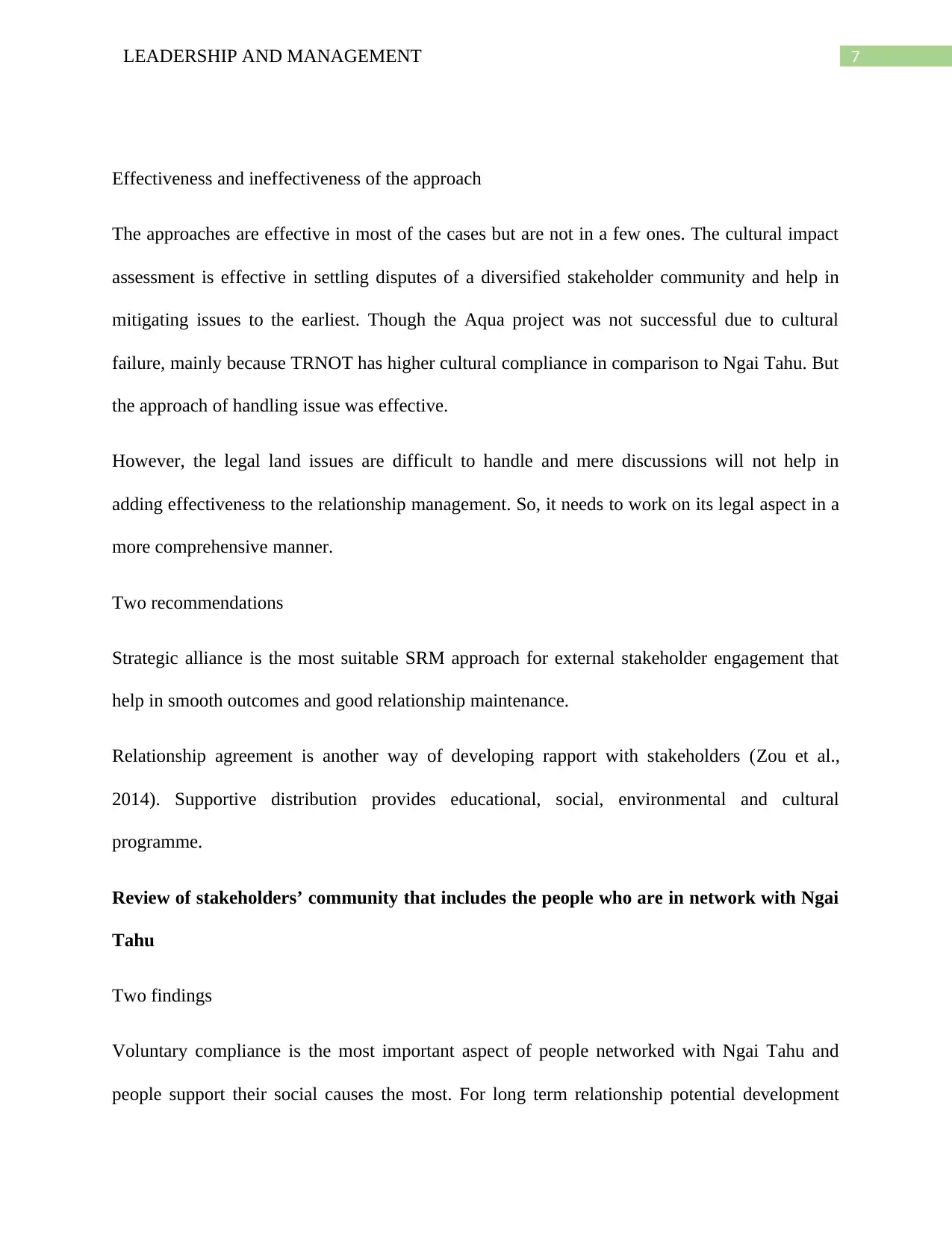
7LEADERSHIP AND MANAGEMENT
Effectiveness and ineffectiveness of the approach
The approaches are effective in most of the cases but are not in a few ones. The cultural impact
assessment is effective in settling disputes of a diversified stakeholder community and help in
mitigating issues to the earliest. Though the Aqua project was not successful due to cultural
failure, mainly because TRNOT has higher cultural compliance in comparison to Ngai Tahu. But
the approach of handling issue was effective.
However, the legal land issues are difficult to handle and mere discussions will not help in
adding effectiveness to the relationship management. So, it needs to work on its legal aspect in a
more comprehensive manner.
Two recommendations
Strategic alliance is the most suitable SRM approach for external stakeholder engagement that
help in smooth outcomes and good relationship maintenance.
Relationship agreement is another way of developing rapport with stakeholders (Zou et al.,
2014). Supportive distribution provides educational, social, environmental and cultural
programme.
Review of stakeholders’ community that includes the people who are in network with Ngai
Tahu
Two findings
Voluntary compliance is the most important aspect of people networked with Ngai Tahu and
people support their social causes the most. For long term relationship potential development
Effectiveness and ineffectiveness of the approach
The approaches are effective in most of the cases but are not in a few ones. The cultural impact
assessment is effective in settling disputes of a diversified stakeholder community and help in
mitigating issues to the earliest. Though the Aqua project was not successful due to cultural
failure, mainly because TRNOT has higher cultural compliance in comparison to Ngai Tahu. But
the approach of handling issue was effective.
However, the legal land issues are difficult to handle and mere discussions will not help in
adding effectiveness to the relationship management. So, it needs to work on its legal aspect in a
more comprehensive manner.
Two recommendations
Strategic alliance is the most suitable SRM approach for external stakeholder engagement that
help in smooth outcomes and good relationship maintenance.
Relationship agreement is another way of developing rapport with stakeholders (Zou et al.,
2014). Supportive distribution provides educational, social, environmental and cultural
programme.
Review of stakeholders’ community that includes the people who are in network with Ngai
Tahu
Two findings
Voluntary compliance is the most important aspect of people networked with Ngai Tahu and
people support their social causes the most. For long term relationship potential development
Paraphrase This Document
Need a fresh take? Get an instant paraphrase of this document with our AI Paraphraser
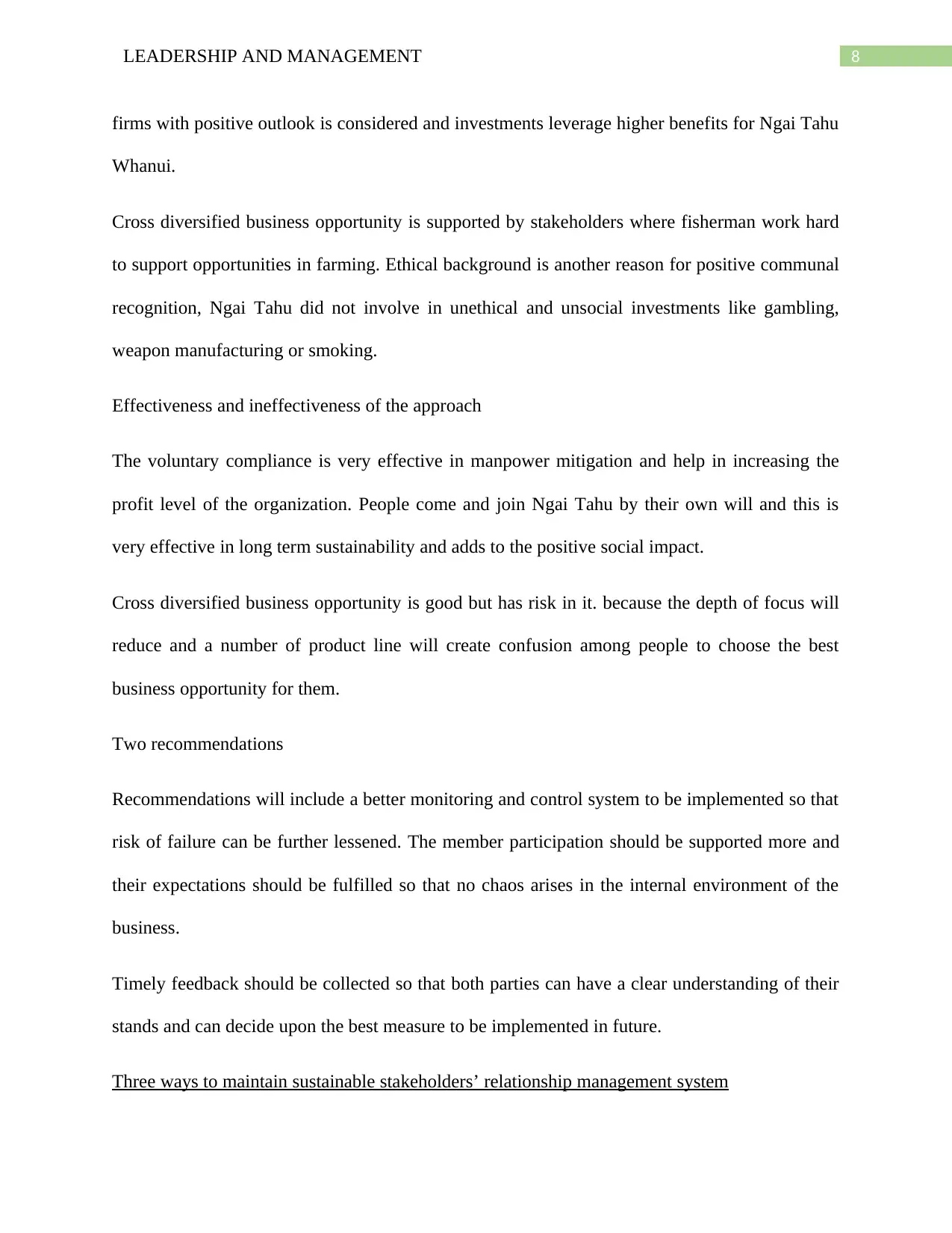
8LEADERSHIP AND MANAGEMENT
firms with positive outlook is considered and investments leverage higher benefits for Ngai Tahu
Whanui.
Cross diversified business opportunity is supported by stakeholders where fisherman work hard
to support opportunities in farming. Ethical background is another reason for positive communal
recognition, Ngai Tahu did not involve in unethical and unsocial investments like gambling,
weapon manufacturing or smoking.
Effectiveness and ineffectiveness of the approach
The voluntary compliance is very effective in manpower mitigation and help in increasing the
profit level of the organization. People come and join Ngai Tahu by their own will and this is
very effective in long term sustainability and adds to the positive social impact.
Cross diversified business opportunity is good but has risk in it. because the depth of focus will
reduce and a number of product line will create confusion among people to choose the best
business opportunity for them.
Two recommendations
Recommendations will include a better monitoring and control system to be implemented so that
risk of failure can be further lessened. The member participation should be supported more and
their expectations should be fulfilled so that no chaos arises in the internal environment of the
business.
Timely feedback should be collected so that both parties can have a clear understanding of their
stands and can decide upon the best measure to be implemented in future.
Three ways to maintain sustainable stakeholders’ relationship management system
firms with positive outlook is considered and investments leverage higher benefits for Ngai Tahu
Whanui.
Cross diversified business opportunity is supported by stakeholders where fisherman work hard
to support opportunities in farming. Ethical background is another reason for positive communal
recognition, Ngai Tahu did not involve in unethical and unsocial investments like gambling,
weapon manufacturing or smoking.
Effectiveness and ineffectiveness of the approach
The voluntary compliance is very effective in manpower mitigation and help in increasing the
profit level of the organization. People come and join Ngai Tahu by their own will and this is
very effective in long term sustainability and adds to the positive social impact.
Cross diversified business opportunity is good but has risk in it. because the depth of focus will
reduce and a number of product line will create confusion among people to choose the best
business opportunity for them.
Two recommendations
Recommendations will include a better monitoring and control system to be implemented so that
risk of failure can be further lessened. The member participation should be supported more and
their expectations should be fulfilled so that no chaos arises in the internal environment of the
business.
Timely feedback should be collected so that both parties can have a clear understanding of their
stands and can decide upon the best measure to be implemented in future.
Three ways to maintain sustainable stakeholders’ relationship management system
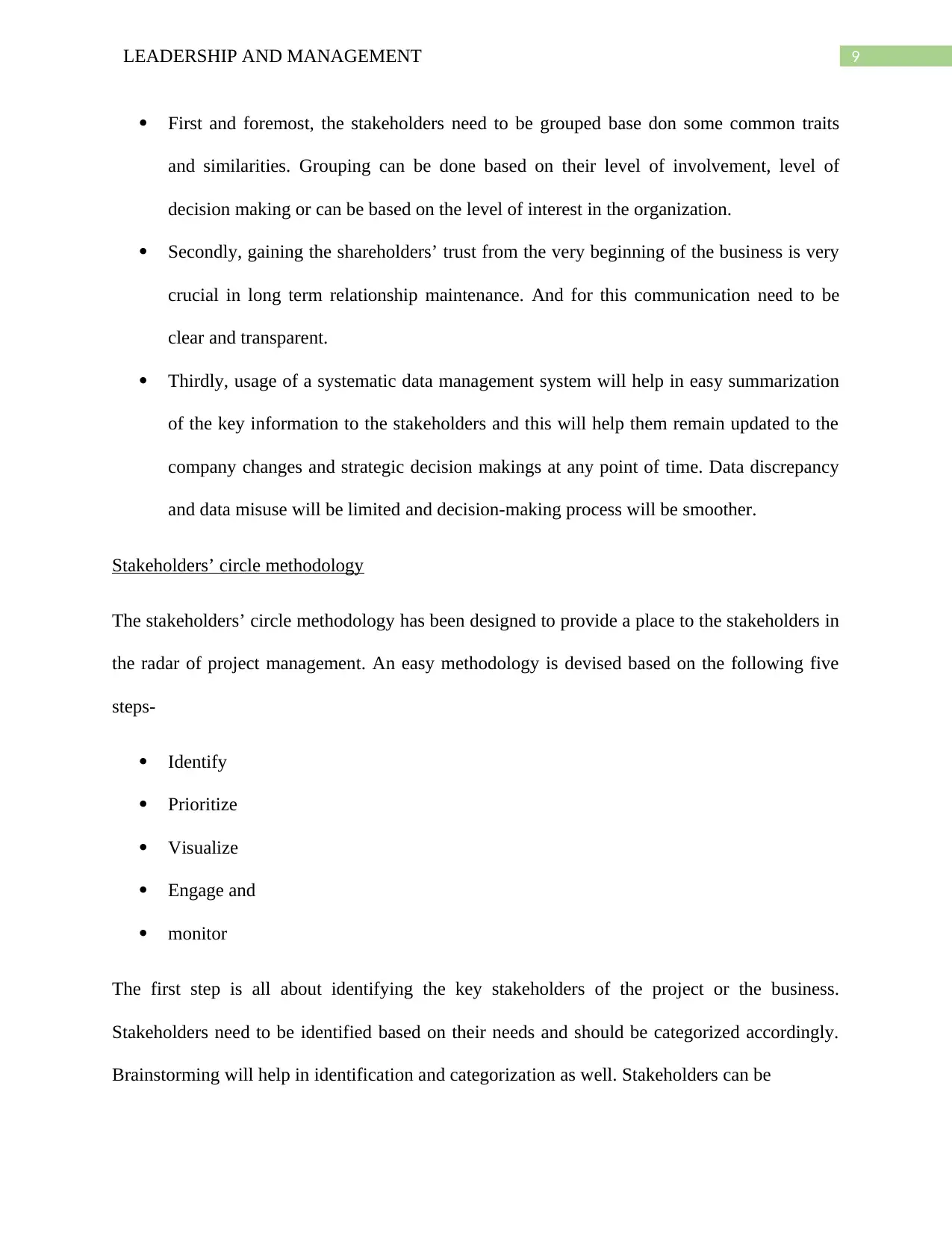
9LEADERSHIP AND MANAGEMENT
First and foremost, the stakeholders need to be grouped base don some common traits
and similarities. Grouping can be done based on their level of involvement, level of
decision making or can be based on the level of interest in the organization.
Secondly, gaining the shareholders’ trust from the very beginning of the business is very
crucial in long term relationship maintenance. And for this communication need to be
clear and transparent.
Thirdly, usage of a systematic data management system will help in easy summarization
of the key information to the stakeholders and this will help them remain updated to the
company changes and strategic decision makings at any point of time. Data discrepancy
and data misuse will be limited and decision-making process will be smoother.
Stakeholders’ circle methodology
The stakeholders’ circle methodology has been designed to provide a place to the stakeholders in
the radar of project management. An easy methodology is devised based on the following five
steps-
Identify
Prioritize
Visualize
Engage and
monitor
The first step is all about identifying the key stakeholders of the project or the business.
Stakeholders need to be identified based on their needs and should be categorized accordingly.
Brainstorming will help in identification and categorization as well. Stakeholders can be
First and foremost, the stakeholders need to be grouped base don some common traits
and similarities. Grouping can be done based on their level of involvement, level of
decision making or can be based on the level of interest in the organization.
Secondly, gaining the shareholders’ trust from the very beginning of the business is very
crucial in long term relationship maintenance. And for this communication need to be
clear and transparent.
Thirdly, usage of a systematic data management system will help in easy summarization
of the key information to the stakeholders and this will help them remain updated to the
company changes and strategic decision makings at any point of time. Data discrepancy
and data misuse will be limited and decision-making process will be smoother.
Stakeholders’ circle methodology
The stakeholders’ circle methodology has been designed to provide a place to the stakeholders in
the radar of project management. An easy methodology is devised based on the following five
steps-
Identify
Prioritize
Visualize
Engage and
monitor
The first step is all about identifying the key stakeholders of the project or the business.
Stakeholders need to be identified based on their needs and should be categorized accordingly.
Brainstorming will help in identification and categorization as well. Stakeholders can be
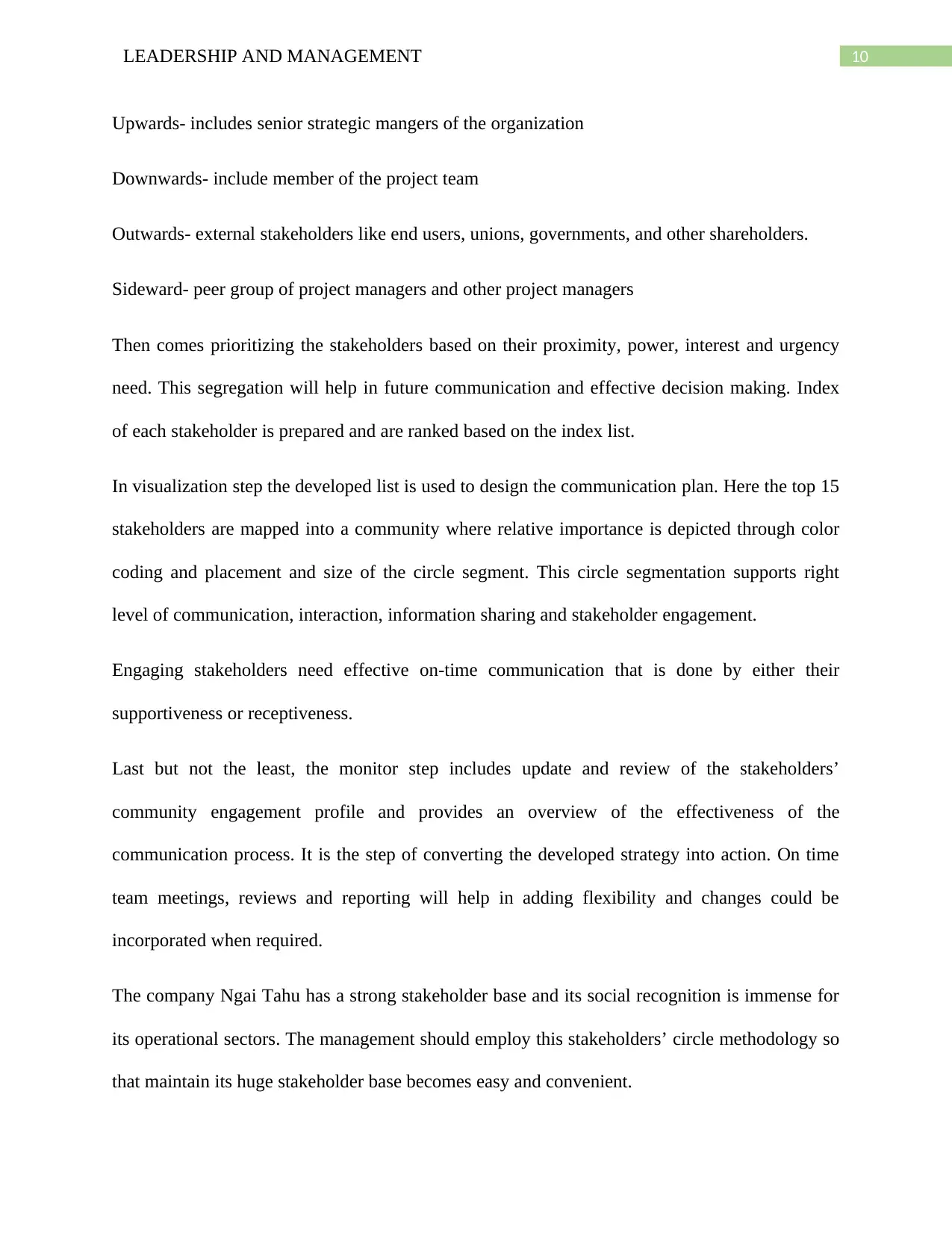
10LEADERSHIP AND MANAGEMENT
Upwards- includes senior strategic mangers of the organization
Downwards- include member of the project team
Outwards- external stakeholders like end users, unions, governments, and other shareholders.
Sideward- peer group of project managers and other project managers
Then comes prioritizing the stakeholders based on their proximity, power, interest and urgency
need. This segregation will help in future communication and effective decision making. Index
of each stakeholder is prepared and are ranked based on the index list.
In visualization step the developed list is used to design the communication plan. Here the top 15
stakeholders are mapped into a community where relative importance is depicted through color
coding and placement and size of the circle segment. This circle segmentation supports right
level of communication, interaction, information sharing and stakeholder engagement.
Engaging stakeholders need effective on-time communication that is done by either their
supportiveness or receptiveness.
Last but not the least, the monitor step includes update and review of the stakeholders’
community engagement profile and provides an overview of the effectiveness of the
communication process. It is the step of converting the developed strategy into action. On time
team meetings, reviews and reporting will help in adding flexibility and changes could be
incorporated when required.
The company Ngai Tahu has a strong stakeholder base and its social recognition is immense for
its operational sectors. The management should employ this stakeholders’ circle methodology so
that maintain its huge stakeholder base becomes easy and convenient.
Upwards- includes senior strategic mangers of the organization
Downwards- include member of the project team
Outwards- external stakeholders like end users, unions, governments, and other shareholders.
Sideward- peer group of project managers and other project managers
Then comes prioritizing the stakeholders based on their proximity, power, interest and urgency
need. This segregation will help in future communication and effective decision making. Index
of each stakeholder is prepared and are ranked based on the index list.
In visualization step the developed list is used to design the communication plan. Here the top 15
stakeholders are mapped into a community where relative importance is depicted through color
coding and placement and size of the circle segment. This circle segmentation supports right
level of communication, interaction, information sharing and stakeholder engagement.
Engaging stakeholders need effective on-time communication that is done by either their
supportiveness or receptiveness.
Last but not the least, the monitor step includes update and review of the stakeholders’
community engagement profile and provides an overview of the effectiveness of the
communication process. It is the step of converting the developed strategy into action. On time
team meetings, reviews and reporting will help in adding flexibility and changes could be
incorporated when required.
The company Ngai Tahu has a strong stakeholder base and its social recognition is immense for
its operational sectors. The management should employ this stakeholders’ circle methodology so
that maintain its huge stakeholder base becomes easy and convenient.
Secure Best Marks with AI Grader
Need help grading? Try our AI Grader for instant feedback on your assignments.
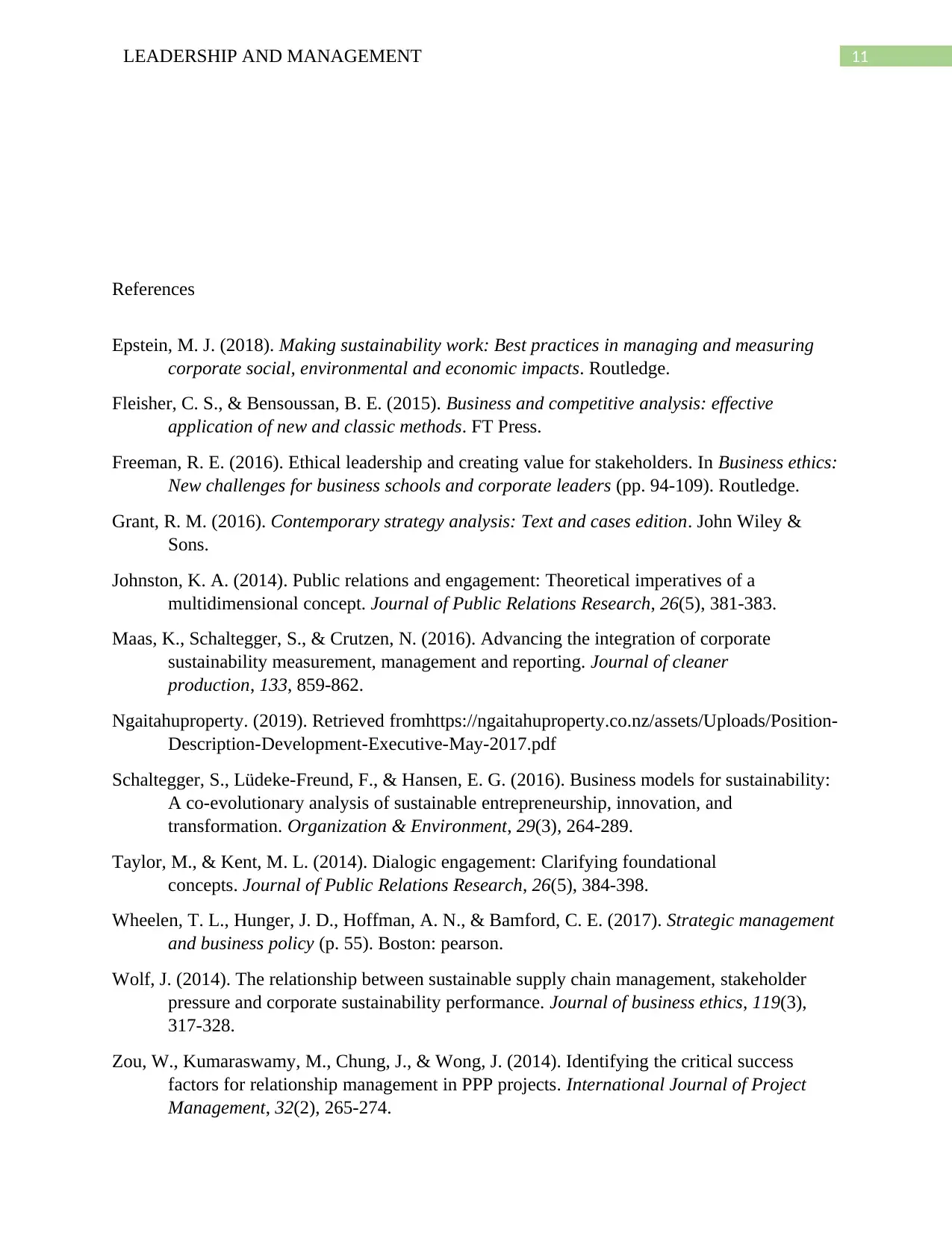
11LEADERSHIP AND MANAGEMENT
References
Epstein, M. J. (2018). Making sustainability work: Best practices in managing and measuring
corporate social, environmental and economic impacts. Routledge.
Fleisher, C. S., & Bensoussan, B. E. (2015). Business and competitive analysis: effective
application of new and classic methods. FT Press.
Freeman, R. E. (2016). Ethical leadership and creating value for stakeholders. In Business ethics:
New challenges for business schools and corporate leaders (pp. 94-109). Routledge.
Grant, R. M. (2016). Contemporary strategy analysis: Text and cases edition. John Wiley &
Sons.
Johnston, K. A. (2014). Public relations and engagement: Theoretical imperatives of a
multidimensional concept. Journal of Public Relations Research, 26(5), 381-383.
Maas, K., Schaltegger, S., & Crutzen, N. (2016). Advancing the integration of corporate
sustainability measurement, management and reporting. Journal of cleaner
production, 133, 859-862.
Ngaitahuproperty. (2019). Retrieved fromhttps://ngaitahuproperty.co.nz/assets/Uploads/Position-
Description-Development-Executive-May-2017.pdf
Schaltegger, S., Lüdeke-Freund, F., & Hansen, E. G. (2016). Business models for sustainability:
A co-evolutionary analysis of sustainable entrepreneurship, innovation, and
transformation. Organization & Environment, 29(3), 264-289.
Taylor, M., & Kent, M. L. (2014). Dialogic engagement: Clarifying foundational
concepts. Journal of Public Relations Research, 26(5), 384-398.
Wheelen, T. L., Hunger, J. D., Hoffman, A. N., & Bamford, C. E. (2017). Strategic management
and business policy (p. 55). Boston: pearson.
Wolf, J. (2014). The relationship between sustainable supply chain management, stakeholder
pressure and corporate sustainability performance. Journal of business ethics, 119(3),
317-328.
Zou, W., Kumaraswamy, M., Chung, J., & Wong, J. (2014). Identifying the critical success
factors for relationship management in PPP projects. International Journal of Project
Management, 32(2), 265-274.
References
Epstein, M. J. (2018). Making sustainability work: Best practices in managing and measuring
corporate social, environmental and economic impacts. Routledge.
Fleisher, C. S., & Bensoussan, B. E. (2015). Business and competitive analysis: effective
application of new and classic methods. FT Press.
Freeman, R. E. (2016). Ethical leadership and creating value for stakeholders. In Business ethics:
New challenges for business schools and corporate leaders (pp. 94-109). Routledge.
Grant, R. M. (2016). Contemporary strategy analysis: Text and cases edition. John Wiley &
Sons.
Johnston, K. A. (2014). Public relations and engagement: Theoretical imperatives of a
multidimensional concept. Journal of Public Relations Research, 26(5), 381-383.
Maas, K., Schaltegger, S., & Crutzen, N. (2016). Advancing the integration of corporate
sustainability measurement, management and reporting. Journal of cleaner
production, 133, 859-862.
Ngaitahuproperty. (2019). Retrieved fromhttps://ngaitahuproperty.co.nz/assets/Uploads/Position-
Description-Development-Executive-May-2017.pdf
Schaltegger, S., Lüdeke-Freund, F., & Hansen, E. G. (2016). Business models for sustainability:
A co-evolutionary analysis of sustainable entrepreneurship, innovation, and
transformation. Organization & Environment, 29(3), 264-289.
Taylor, M., & Kent, M. L. (2014). Dialogic engagement: Clarifying foundational
concepts. Journal of Public Relations Research, 26(5), 384-398.
Wheelen, T. L., Hunger, J. D., Hoffman, A. N., & Bamford, C. E. (2017). Strategic management
and business policy (p. 55). Boston: pearson.
Wolf, J. (2014). The relationship between sustainable supply chain management, stakeholder
pressure and corporate sustainability performance. Journal of business ethics, 119(3),
317-328.
Zou, W., Kumaraswamy, M., Chung, J., & Wong, J. (2014). Identifying the critical success
factors for relationship management in PPP projects. International Journal of Project
Management, 32(2), 265-274.
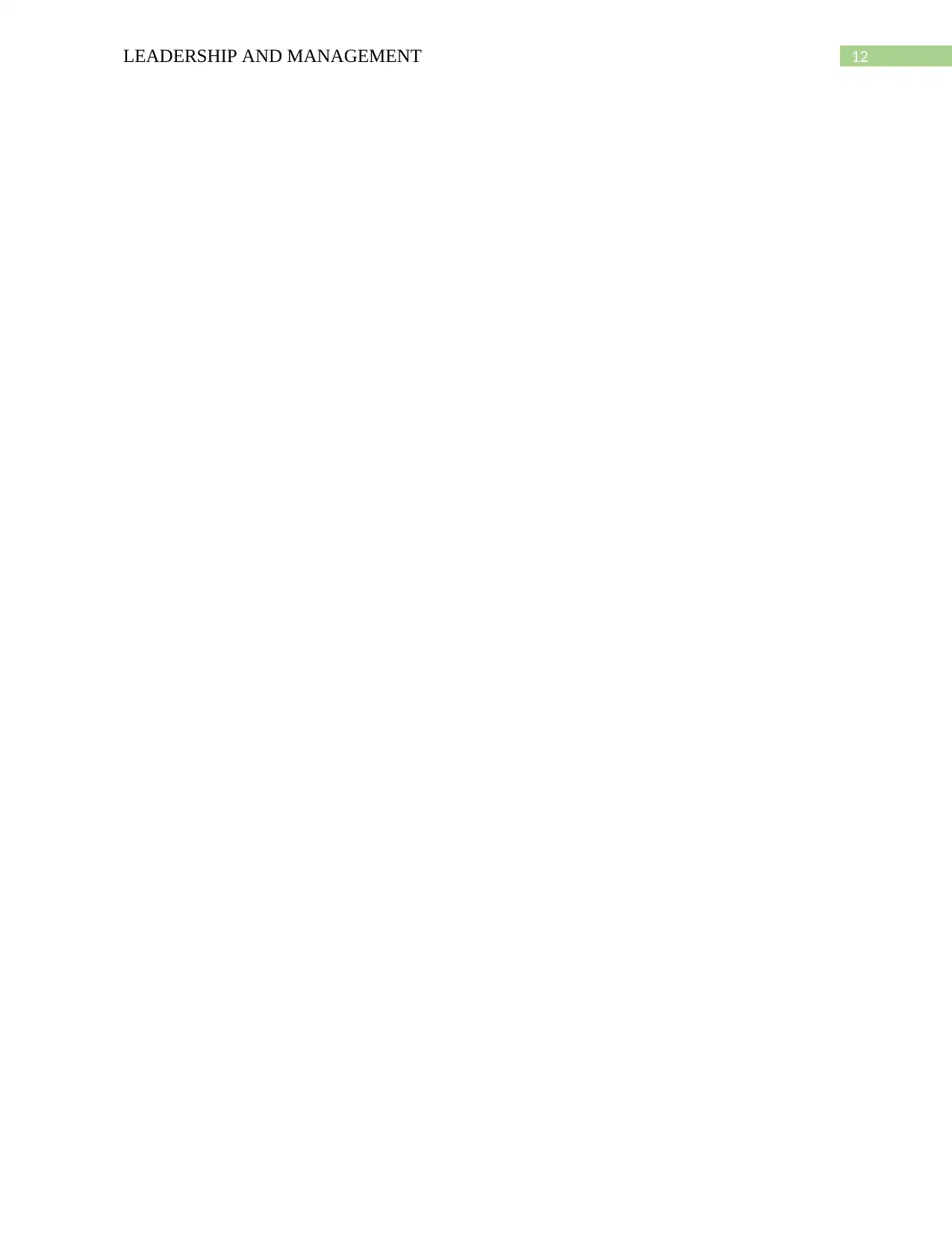
12LEADERSHIP AND MANAGEMENT
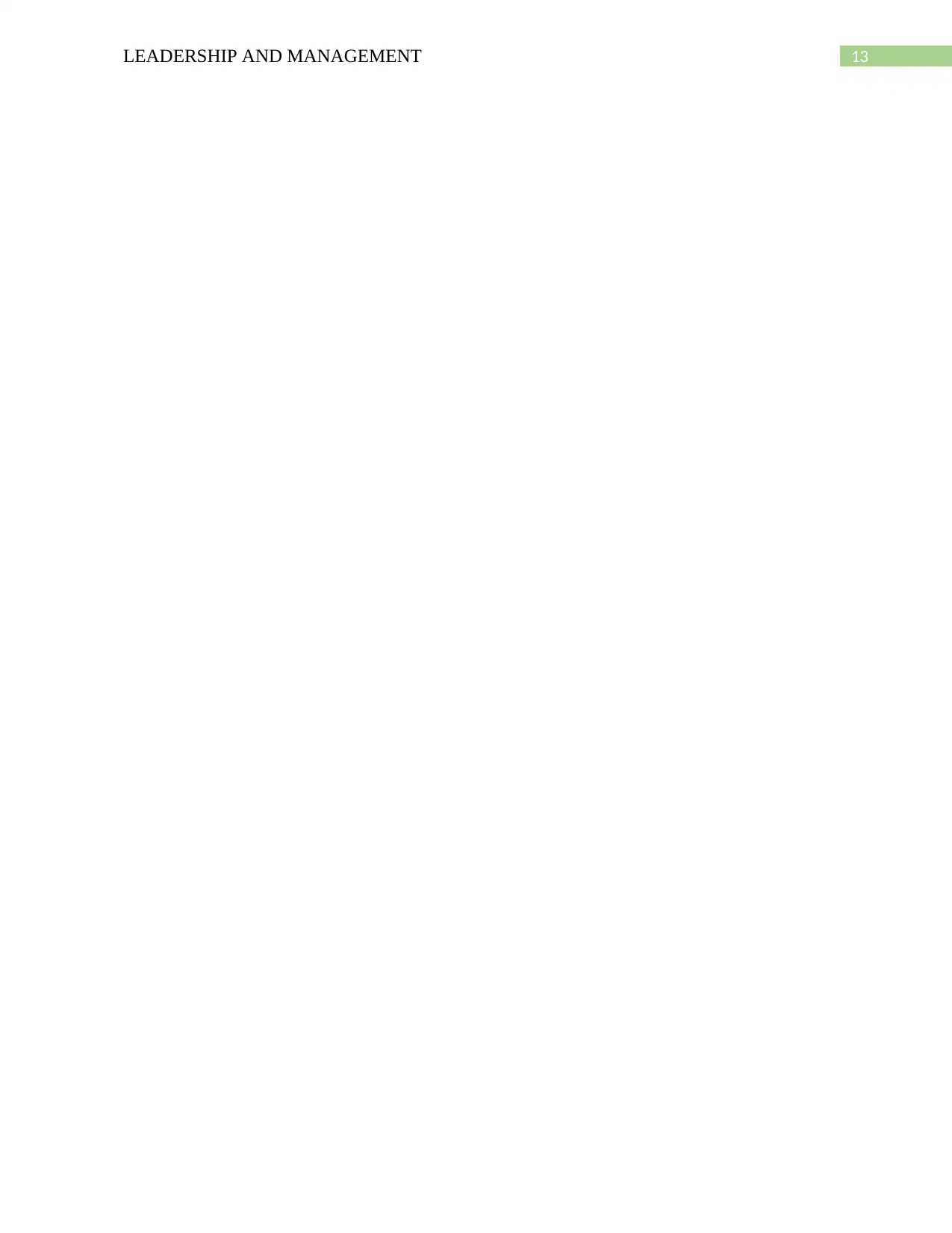
13LEADERSHIP AND MANAGEMENT
1 out of 13
Your All-in-One AI-Powered Toolkit for Academic Success.
+13062052269
info@desklib.com
Available 24*7 on WhatsApp / Email
![[object Object]](/_next/static/media/star-bottom.7253800d.svg)
Unlock your academic potential
© 2024 | Zucol Services PVT LTD | All rights reserved.